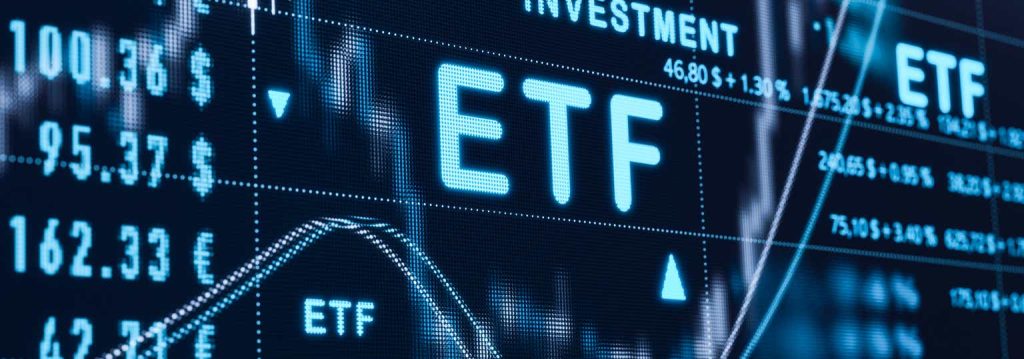What a difference a quarter makes. Heading into Q2, the global stock market rally had been broadening nicely. Small caps were participating in the upside while non-US equities were actually beating their large-cap US counterparts. What’s more, relative strength was seen in areas away from just the Information Technology and Communication Services sectors. Niches like Financials, Industrials, and Energy were charging ahead even as odds for significant rate cuts from the Federal Reserve were erased from 2024’s monetary policy chalkboard one by one.
That all changed starting around mid-April. Tax Day marked an inflection at which mega-cap tech reasserted its dominance. By May 1, another massive leg to the AI-driven rally had begun to take place. Jump ahead to today, and the Magnificent Seven has condensed into the Terrific Triumvirate. NVIDIA (NVDA) has leapfrogged Microsoft (MSFT) and Apple (AAPL) to become the world’s most valuable company, and the I.T. sector writ large is now more than 30% of the S&P 500.
I am downgrading the JPMorgan Equity Premium Income ETF (NYSEARCA:JEPI) from a buy to a hold. The covered-call fund performed well in the weeks after my previous analysis but has underperformed lately amid the growth-on rally. With low implied volatility in the broad market, owning it today offers less option-selling income.
Tech Sector Dominance Since May 1
Koyfin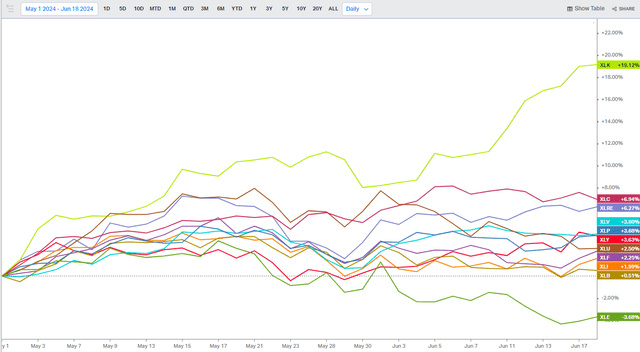
A Low VIX Results In Reduced Option-Selling Income
TradingView
According to the issuer, JEPI generates income through a combination of selling options and investing in U.S. large-cap stocks, seeking to deliver a monthly income stream from associated option premiums and stock dividends. The ETF’s managers construct a diversified, low-volatility equity portfolio through a proprietary research process designed to identify over- and undervalued stocks with attractive risk/return characteristics. Overall, JEPI seeks to deliver a significant portion of the returns associated with the S&P 500 Index with less volatility, in addition to monthly income.
JEPI is a large ETF with more than $33 billion in assets under management as of June 18, 2024. Its 0.35% annual expense ratio is low given the complexity of the strategy while the fund’s trailing 12-month dividend yield is high at 7.4%. Prospective investors should understand that most of the income is generated from selling call options, not just from the cash flows of the portfolio’s equity holdings.
Share-price momentum has been lukewarm lately as JEPI’s allocation is akin to an equal-weight strategy, so it has underperformed its cap-weighted fund peers that have very high exposure to mega-cap growth stocks. But JEPI scores well across risk metrics given its diversified portfolio and somewhat modest annual standard deviation history. Liquidity is another strong point given JEPI’s high average daily volume of more than three million shares and a median 30-day bid/ask spread of just two basis points, per JPMorgan.
Looking closer at the portfolio, the 4-star, Bronze-rated ETF by Morningstar remains primarily a large-cap allocation. It’s more balanced between value and growth compared with the S&P 500, and there is a material position in domestic mid-cap stocks. This tells me that JEPI should do well when the so-called S&P 493 does well, not just the Mag 7.
What has me concerned though is the valuation. Now close to 22x earnings, the fund is by no means a bargain. But with a long-term EPS growth rate under 12%, the PEG ratio is a smidgen from 2.0, which is not tremendously expensive.
JEPI: Portfolio & Factor Profiles
Morningstar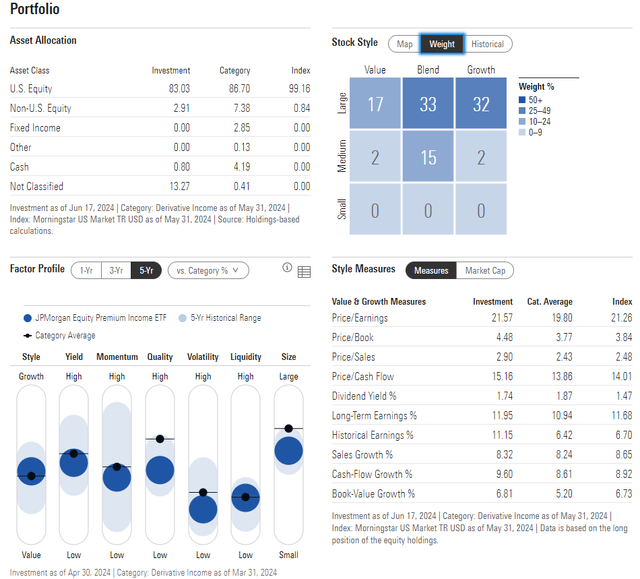
Where you’ll find a significant difference in JEPI versus the broader domestic stock market is in its sector breakdown. Tech is just 20% of the ETF, a significant underweight compared to the SPX while areas like Industrials, Consumer Staples, and Utilities are overweights. The 133-position portfolio acts like an equal-weight product, given that the biggest single stock is 1.74% and turnover is high at 190%.
JEPI: Sector Diversification, Not a Top-Heavy Allocation
Seeking Alpha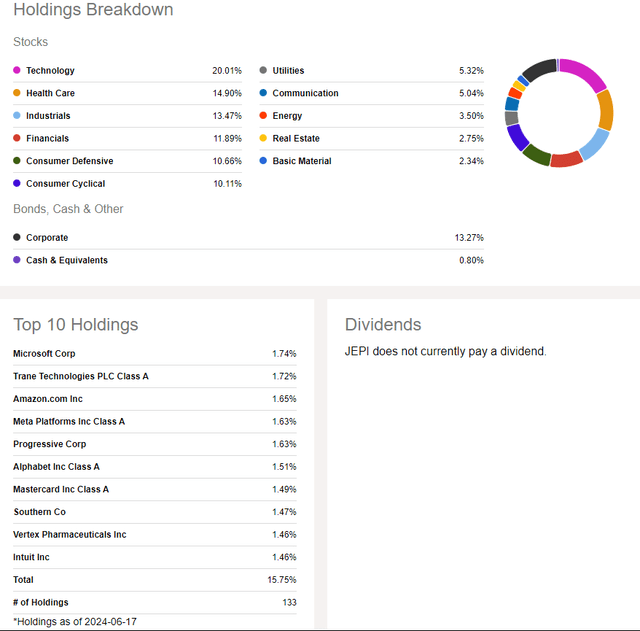
Seasonality is not a major consideration given the fund’s short history, but eyeing the monthly trends, we find that July tends to be a decent month. Of course, the first month of the second half is among the best periods for the S&P 500 as well. A favorable time to get long JEPI is after implied volatility has increased, perhaps later in Q3 if history is a guide.
JEPI: Bullish July Trends
Seeking Alpha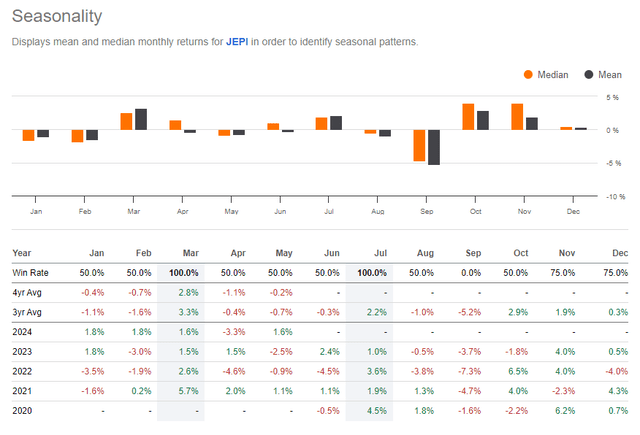
The Technical Take
Charting the fund, we should first keep in mind that the high dividend payouts cause price gaps, but we can still glean an idea of the current trend and important price points to monitor. Notice in the graph below that the bulls look to be in charge of the primary trend. I come to that assertion given that the long-term 200-day moving average is positively sloped and shares continue to hold important support around the $55 level. Back in Q1, I noted that an upside breakout took place and that higher prices were likely. That played out, but the rally petered out two months later.
Today, I’d like to see JEPI climb above its 2024 peak just shy of the $58 mark on higher volume. I don’t like that volume has been on the decline for much of this year, though it is still very much an actively traded ETF. Also, the RSI momentum indicator at the top of the chart has rolled over after being strong during the first quarter. Still, a healthy amount of volume by price in the mid-$50s should provide support today.
Overall, momentum has eased with JEPI, but its uptrend remains intact.
JEPI: Holding Key Support, Rising 200dma
StockCharts.com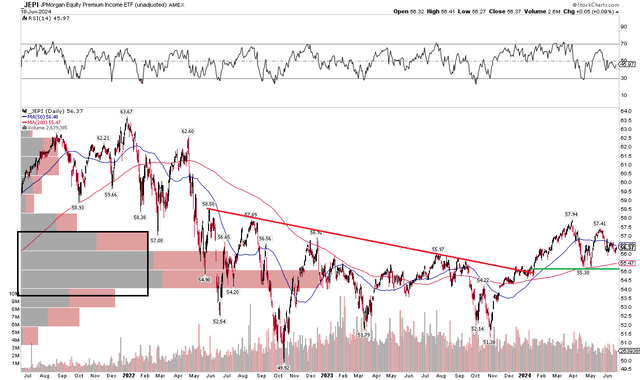
The Bottom Line
With a VIX near 12 and few signs of a major let-up in the mega-cap growth momentum trade, waiting for better macro and intermarket trends is prudent with JEPI. I like the strategy for investors seeking high income, but patience is needed for higher options pricing to take advantage of the call-selling strategy.
Read the full article here






